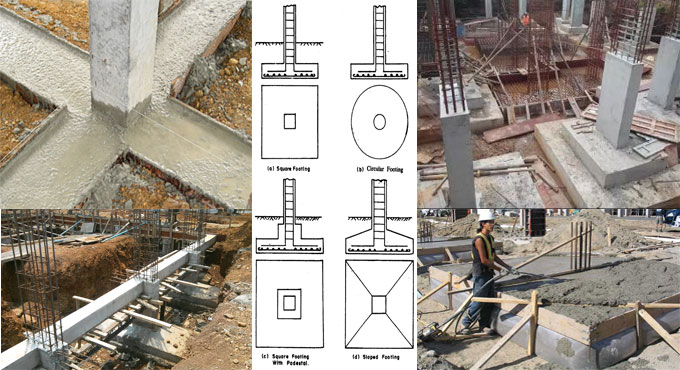
Some vital points in concrete footings
The purpose of concrete footings is to transmit different types of structural loads (snow load, live load, dead load, wind load, earthquake load, etc.) from the building to the soil. Apparently, the foundations of a building are crucial from a structural point of view.
If the foundation is not strong enough, the longevity of the building will be hampered considerably. The Construction Supervisor should take the responsibility to recognize both the function and the agreeable tolerances on foundations. For this purpose, proper attention should be given on the following topics :-
1. Concrete spread footing under a single column: This footing normally contains the column in the middle of the footing. Due to fact that the force operates downward from the column, the spread footing disperse that force to the soil. The bottom of the spread footing is in tension from the bending moment formed with the column force and the earth resistance.
Various normal spread footings having a single column are designed with Construction Reinforcing Steel Institute (CRSI) Tables for Footings. The engineers prefer to employ these tables, or computer design software instead of designing footings by hand every time.
2. Concrete wall footing: This footing comprises of continuous wall over. The forces which operate downward during the wall are allocated with the wall footing to the Earth.
3. Concrete spread footing under multiple columns: The layout of this footing fluctuates frequently on the basis of the column locations and loads. Due to the variations in the bending moments, footing rebar is necessary on a regular basis in the top and bottom of spread footings having several columns.
Steps and plan the job for footing:
For setting up the footing, some site works are necessary. The planning for the footings generally starts with the building construction process. All other building works are dependent on the footings. So, proper consideration should be given to make the proper footing planning and implement it efficiently.
One of the crucial steps in planning the footing work is selecting the exact location of the adjacent sub grade. In some cases, it?s recommended to retain the existing grade low, install the footings with minimum excavation, then arrange the fill in the building after footing and foundation wall excavation.
In most cases, it is recommended to deliver the building pad to final sub-grade before commencing the footing excavation. It should be applied to each project.

The layout of the footings as well as what should be done with the extra soil material of the footing excavation, should be taken into consideration jointly. Some construction supervisors employ batter boards at every corner to provide the line and the grade of the building. Others apply offset hubs to set line and an elevation benchmark for grade. With both the process, you have to determine how much offset is essential from the actual wall lines to complete the excavation. These items should be considered ahead of the actual layout and footing excavation to make the process efficient.
For more information, go through the following article constructionknowledge.net

